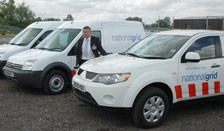Knowing your fleet’s carbon footprint can be a useful starting point for reducing emissions and – ultimately – cost.
National Grid recently enlisted the help of the Energy Saving Trust (EST) through a Green Fleet Review to calculate the carbon footprint of its fleet.
“National Grid, as a business, has made a commitment to reduce its carbon footprint by 80% by 2050 and fleet is part of that,” says Gary Foster, fleet operations manager.
The EST calculated the fleet was emitting 34,566 tonnes of CO2, a year based on 12,786 vehicles. This included vans up to 3.5 tonnes, company cars, cash allowance drivers, grey fleet drivers and daily rental vehicles.
Foster continues: “There are about 250,000 vehicles in the utilities sector. If we’re producing more than 34,000 tonnes of carbon you have to wonder how much is being produced by the utilities group as whole.
"But it’s not just about looking after the planet. Operationally, introducing green fleet policies can save money too.”
Foster won’t know exactly how much National Grid has saved until a year’s time. “It’s early days,” he says, “but we aim to save between 10% and 15% on fuel, which equates to £1 million.”
Choosing cleaner cars
One green policy National Grid has in place is an incentive scheme to encourage drivers to opt for vehicles emitting 120g/km of CO2 or less.
The company operates a user-chooser scheme with employees receiving a monthly allowance. If an employee opts for a cleaner car they receive an extra 15% a month.
Since the scheme was introduced in November last year, the number of sub-120g/km vehicles on the fleet has increased from 167 to 278.
National Grid operates a CO2 limit of 190g/km on company cars. It intends to reduce this to 160g/km by April 2010, with the EST recommending a further reduction to 140g/km.
Greener models are also being introduced to the commercial vehicle fleet, with National Grid opting for the Ford Transit Econetic range.
Foster says the biggest challenge when greening the fleet is changing driver behaviour and that communication is key.
“We’re running a campaign called ‘foot off the gas’,” he says. “It reminds drivers about checking tyre pressure, avoiding harsh braking and planning their journeys properly.”
National Grid introduced a car sharing scheme four years, ago with 350 employees who work at its office in Warwick, where the fleet department is based, taking part. It also provides subsidised coaches and travel by train, as well as promoting cycling to work.
Foster started pushing tele-conferencing a year ago and says the message to drivers is: “Think before you travel.”
A number of electric and hybrid trials are planned this year, with vehicles such as Modec’s electric van being used in Coventry and Connaught’s retro-fit hybrid technology being trialled in London.
Aftermarket fuel-saving device
Three company cars will have an aftermarket fuel-saving device fitted.
The device fits in the air intake system and is claimed to give a more efficient burn. If the predicted fuel savings of 6% are achieved, Foster will look at introducing it to other vehicles.
National Grid was an early adoptee of speed limiters. It has them on its vans for the past 10 years, restricting them to 70mph. It is now considering rev limiters.
“The speed limiters were introduced to protect drivers and to protect the company image rather than for environmental reasons,” Foster says.
“But there are fuel savings to be made from restricting speed – research shows that you use about 10% more fuel for every 5mph above 60mph.
The EST has recommended having speed limiters at 62mph – or even 56mph to bring bigger fuel savings.”
Telematics is another recommendation by the EST as it can also bring fuel savings.
“We’ve had telematics in the past but we’re didn’t get the fleet data we wanted from it,” Foster says.
“We’ll be looking for a system that can provide more management information that will allow us to drive down costs.”
















Login to comment
Comments
No comments have been made yet.